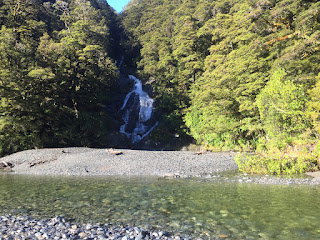We returned to stay at the Makarora Tourist Centre with some trepidation: the 1080 poison drop over the whole Makarora Valley area had been carried out 3 months before. The question was, had all the beautiful wildlife that we witnessed back in January when we last visited, survived? What would we be faced with after this travesty on our environment including the wide expanse of rivers?
 |
| Upon arrival at the Campsite at the Makarora Tourist Centre |
 |
| One of the all-too-familiar poison warning signs (this one approaching the Blue Pools Walkway at Mount Aspiring National Park) that are now ubiquitous around NZ forests and walkways. |
I knew the poison hadn't been scheduled to reach as far as the Tourist Centre itself (that would be far too risky for DoC to pursue without having to answer some very uncomfortable questions), but it was very near - 5 mins drive away in fact, at the famous and popular Blue Pools was where the 'conservation' operation area began and run many hundreds of Kms North and East of there.
 |
| One of the beautiful waterfalls along the Blue Pools tracks... |
OIAs that me and colleagues have undertaken about this particular 'pest control' operation reveal that (like numerous others) no assessment of possum numbers was carried out (either before or after) and that the assessment of rat numbers (although very agricultural in methodology and questionable in validity) was actually well below DoCs own guidelines that form a rationale for a poison operation. These OIAs continually throw the whole DoC and TBFree (Ospri) poison industry into question. This is effectively, undoubtedly, fraud - taxpayers' funds being used with no rationale for poisoning operations that are not subjected to any accountability or auditing. I've witnessed - and been a victim of - the bullying tactics of these public-servants who try to protect their gravy-trains. It's not acceptable in a so-called developed country for individuals to be subjected to this kind of harassment. And will the media even report these events? Very rarely. We rely on the small, independent press to attempt to expose some of the research - e.g. like this. and more recently this.
 |
| The surrounding area of the campsite... |
Anyway, it was a lovely day and back to the Blue Pools walk we went later that day (we left Dizzy behind at the camp). And there were a few tourists there, mainly from Asia, looking around at the scenery in awe. I asked one of them: "what do you hear?" And they listened...."errrr, water?" they responded. Mmmm indeed. Very little bird song here. Especially compared to our last visit where Kereru were flying past us in flocks every minute.
 |
| The famous Blue Pools - this is the view from the bridge at the beginning of the Mount Aspiring tracks... |
In contrast, the birdsong just a few kms away when we got back at the campsite was still (thankfully) uplifting and prolific:
 |
| Dizzy keeping warm by the campsite kitchen wood burner. :) |
 |
| A hearty non-vegetarian meal - Poison-free. |
Back at camp we found the kitchen empty, so we relaxed a bit and lit the communal fire and cooked some of the wild pig that we had been given by a friend down in Otautau - poison-free of course. Some fresh veggies and local wine lifted our spirits after witnessing the poison signs all around us and the silence along the tracks. Probably the most upsetting was the apparent total ignorance of the tourists there, who didn't even look at the (English only) warning signs. Oblivious to the dangers, as Clyde Graf highlighted in the recent film about this poisoned area.
 |
| The irony of this sign over the campsite kitchen's sink wasn't lost on me! |
Whilst on our journey I systematically read any books I could get hold of that may provide some clues about the views of New Zealanders about their environment. One of the books I had at hand during this part of our trip was the biography of 2 journos called Ric Oram and Louise Joyce, An Autumn Journey which tells of their move from 'city' life in Auckland to running a rural B&B in Otago - not far from where we had been last week in Alexander. This excerpt published 10 years ago, illustrates the apparent normalisation of having pets traumatically killed by 1080 poison:
 |
| Para from the book mentioned above: An Autumnal Journey |
Whilst in the area, we visited nearby Haast and had tea with a friend in the township there. The local Dairy was very friendly and the town was much quieter than we have imagined. No phone coverage here, no wifi and not even any 3G signal. It felt very isolating. In fact, the local hotel owner told us how often he has to point out to guests that there is no communication possible here (other than the archiac PCs and 'dial-up' for $5 for 5 mins at the local shop). Often, upon realising how dire the situation is here they get straight back in their rental cars and head off...
This is a real shame for the struggling community which is surrounded by poisoned rivers and bush. No hunting here. And the local (dog-friendly) beaches are just stunning (although I didn't let Dizzy out of my sight for one second in case of the risk of secondary poisoning):
 |
| Haast beach, looking North |
 |
| Loads of beautiful driftwood along this stretch of lonely beach... |
 |
| One of the tributaries leading out to the beach with the unused whitebait stations along the edge... |

No comments:
Post a Comment